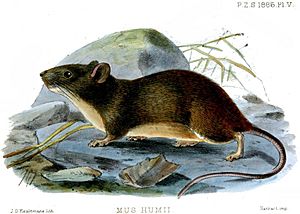Manipur bush rat facts for kids
Quick facts for kids Manipur bush rat |
|
|---|---|
 |
|
| Conservation status | |
| Scientific classification | |
| Genus: |
Hadromys
|
| Species: |
humei
|
| Synonyms | |
|
Mus humei, Mus humii |
|
The Manipur bush rat (Hadromys humei), also known as Hume's rat, is a type of rodent found in India. It belongs to the family Muridae, which includes mice and rats. This special rat lives in northeastern India and is currently listed as an endangered species, meaning it's at high risk of disappearing forever.
Where It Lives
This rat is found only in northeast India. It has been seen in several places there. These include Angarakhata in the Kamrup area of Assam. It's also found in Bishnupur, Imphal, Senapati, and Karong in Manipur.
People once thought it also lived in Yunnan, China. However, the rats found in China are now known to be a different species. They are called Hadromys yunnanensis.
Old fossil records show that Manipur bush rats used to live all over Thailand. They were found as far south as the Thai-Malay border during the Pleistocene Ice Age. Back then, the climate in this region might have been cooler and drier. It may have had areas that looked like savannas, which are grassy plains. Another related species has been found as fossils in northern Pakistan. These discoveries suggest that the Manipur bush rat is a "relict" species. This means it's a survivor from a time when its relatives were more widespread.
The Manipur bush rat lives in places that are not too high up. It prefers altitudes from about 900 to 1,300 meters (2,950 to 4,265 feet) above sea level. It makes its home in tropical evergreen forests. It also lives in moist deciduous forests and secondary forests in northeastern India.
How It Was Discovered
This type of rat was first described by Oldfield Thomas in 1886. He studied specimens from the Manipur collection of Allan Octavian Hume. Hume was a British official who loved studying birds. He had a huge collection of notes about birds. Sadly, a servant once sold these notes as waste paper. After this, Hume donated his animal collection to the British Museum (Natural History).
The Manipur bush rat was named in Allan Octavian Hume's honor. The collection has two male and two female rats. They were collected on March 23, 1881, from a place called "Moirang" in Manipur. This is the original place where the species was first found and studied.
What It Looks Like
The largest Manipur bush rat specimen found was a female. Her head and body were about 125 millimeters (5 inches) long. Her tail was about 106 millimeters (4 inches) long.
Other measurements show that their head and body length can be from 95 to 140 millimeters (3.7 to 5.5 inches). Their tail can be from 95 to 140 millimeters (3.7 to 5.5 inches) long. The weight of these rats usually ranges from 41 to 77 grams (1.4 to 2.7 ounces).
Why It's Endangered
The Manipur bush rat is listed as "Endangered" by the IUCN Red List. This means it is at a very high risk of becoming extinct in the wild. This assessment is based on several reasons:
- It lives in a very small area, less than 500 square kilometers (193 square miles).
- Its total living range is also small, less than 5,000 kilometers (3,100 miles).
- It has been reported from fewer than five different places.
- Its habitat is constantly shrinking and getting worse.
The main threats to this rat are the loss of its home and the damage to its environment. Its habitat is also becoming broken up into smaller pieces. Other problems include hunting and forest fires. All these things make it harder for the Manipur bush rat to survive.


